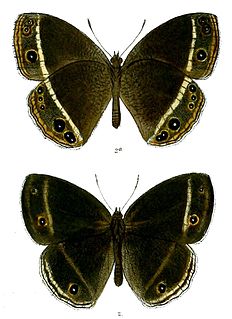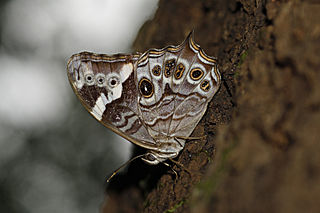
Mycalesis anaxias, the white-bar bushbrown, is a species of satyrid butterfly found in South and Southeast Asia. In South Asia, it inhabits Sikkim, eastwards through the hill-ranges to Assam, Cachar, Myanmar and Tenasserim. Also in southern India, in the Nilgiris and Travancore.

Charaxes marmax, the yellow rajah, is a butterfly found in India that belongs to the rajahs and nawabs group, that is, the Charaxinae group of the brush-footed butterflies family.

Hypolimnas misippus, the Danaid eggfly, mimic, or diadem, is a widespread species of nymphalid butterfly. It is well known for polymorphism and mimicry. Males are blackish with distinctive white spots that are fringed in blue. Females are in multiple forms that include male-like forms while others closely resemble the toxic butterflies Danaus chrysippus and Danaus plexippus.

Mycalesis mineus, the dark-brand bush brown, is a species of satyrine butterfly found in Asia.

Mycalesis mestra, the white-edged bushbrown, is a species of satyrine butterfly found in Asia
Mycalesis nicotia, the brighteye bushbrown, is a species of satyrine butterfly found in Asia.

Junonia almana, the peacock pansy, is a species of nymphalid butterfly found in Cambodia and South Asia. It exists in two distinct adult forms, which differ chiefly in the patterns on the underside of the wings; the dry-season form has few markings, while the wet-season form has additional eyespots and lines.It is listed as Least Concern in the IUCN Red List.

Cethosia nietneri, the Tamil lacewing, is a species of nymphalid butterfly found in Sri Lanka and south India. The species name is after John Nietner who obtained specimens of the butterfly from Ceylon from which it was described.

Lethe rohria, the common treebrown, is a species of satyrine butterfly found in Asia.

Ypthima huebneri, the common fourring, is a species of Satyrinae butterfly found in Asia.

Vindula erota, the common cruiser, is a species of nymphalid butterfly found in forested areas of tropical South Asia and Southeast Asia.

The Indian fritillary is a species of butterfly of the nymphalid or brush-footed family. It is usually found from south and southeast Asia to Australia.

Stichophthalma nourmahal, is a South Asian butterfly that belongs to the Morphinae subfamily of the brush-footed butterflies family.

Enispe cycnus, the blue caliph, is a species of nymphalid butterfly found in Southeast Asia.

Lethe confusa, the banded treebrown, is a species of butterfly belonging to the satyr family that is found mainly in Southeast Asia and in parts of South Asia.

Vagrans is monotypic genus with the species vagrant a species of nymphalid butterfly found in forested areas of tropical South Asia and Southeast Asia.

Nymphalis xanthomelas, the scarce tortoiseshell, is a species of nymphalid butterfly found in eastern Europe and Asia. This butterfly is also referred as yellow-legged tortoiseshell or large tortoiseshell.

Chitoria sordida, the sordid emperor, is a species of nymphalid butterfly found in tropical Asia.

Junonia orithya is a nymphalid butterfly with many subspecies occurring from Africa, through southern and south-eastern Asia, Cambodia and in Australia. In India, its common English name is the blue pansy, but in southern Africa it is known as the eyed pansy as the name blue pansy refers to Junonia oenone. In Australia, this butterfly is known as the blue argus, but this name also is used for the Aricia anteros in Europe.

Junonia iphita, the chocolate pansy or chocolate soldier, is a butterfly found in Asia.























